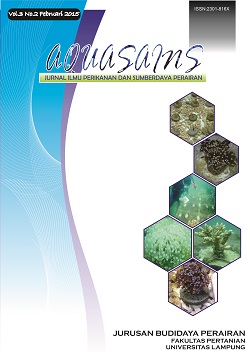Pengaruh Padat Tebar Terhadap Pertumbuhan Dan Kualitas Udang Windu (Penaeus monodon) Pada Sistem Nurseri
Abstract
The low productivity during extensive culture of tiger shrimp (Penaeus monodon) may caused by disability to environmental adaptation of shrimp during cultured period. Nursery system build up to minimize this constrains and enhances shrimp growth, quality and variation in natural pond system. Nursery system is cultured method to take care shrimp during post larvae to juvenile size within 14 days. The objective of this research is to measure the growth and the quality of post larvae shrimp during nursery system at different density which is 750; 1250; 1750 and 2250 shrimps/m2, respectively. The observation of juvenile quality was done to observe the digestive tract, weight variation, necrosis and parasite fouling. In the other side, growth observation was observed by the total length and the body weight. The result showedgrowth and quality of shrimp significantly differentwithin different density. In contrast survival rate of shrimp in differeny density not significantly different. The density of 750 shrimp/m2during nursery system in extensive shrimp culture showed optimum in growth and quality.Shrimp production rose optimum size at 2250 shrimp/m2. The simulation of economic analysis of shrimp production showed benefit to farmer in 1750 shrimp/m2 of density. This study support shrimp production in traditional method may increase with nursery system and additional feed in short period (2 weeks).
Downloads
Downloads
Published
How to Cite
Issue
Section
License
License for Authors
Authors who publish with this journal agree to the following terms:
- Authors retain copyright and grant the journal right of first publication with the work simultaneously licensed under a Creative Commons Attribution License that allows others to share the work with an acknowledgement of the work's authorship and initial publication in this journal.
- Authors are able to enter into separate, additional contractual arrangements for the non-exclusive distribution of the journal's published version of the work (e.g., post it to an institutional repository or publish it in a book), with an acknowledgement of its initial publication in this journal.
- When the article is accepted for publication, its copyright is transferred to Aquasains Journal. The copyright transfer convers the exclusive right to reproduce and distribute the article, including offprint, translation, photographic reproduction, microfilm, electronic material, (offline or online) or any other reproduction of similar nature.
- Authors are permitted and encouraged to post their work online (e.g., in institutional repositories or on their website) prior to and during the submission process, as it can lead to productive exchanges, as well as earlier and greater citation of published work (See The Effect of Open Access).
- The Author warrant that this article is original and that the author has full power to publish. The author sign for and accepts responsibility for releasing this material on behalf os any and all-author. If the article based on or part os student’s thesis, the student needs to sign as his/her agreement that his/her works is going published.
License for Regular Users
Other regular users who want to cite, distribute, remix, tweak, and build upon author’s works, even for commercial purposes, should acknowledge the work’s authorship and initial publication in this journal, licensed under a Creative Commons Attribution License.
This license lets others distribute, remix, tweak, and build upon your work, even commercially, as long as they credit you for the original creation.
This work is licensed under a Creative Commons Attribution 4.0 International License.Copyright Transfer Statement can be downloaded here


.png)









